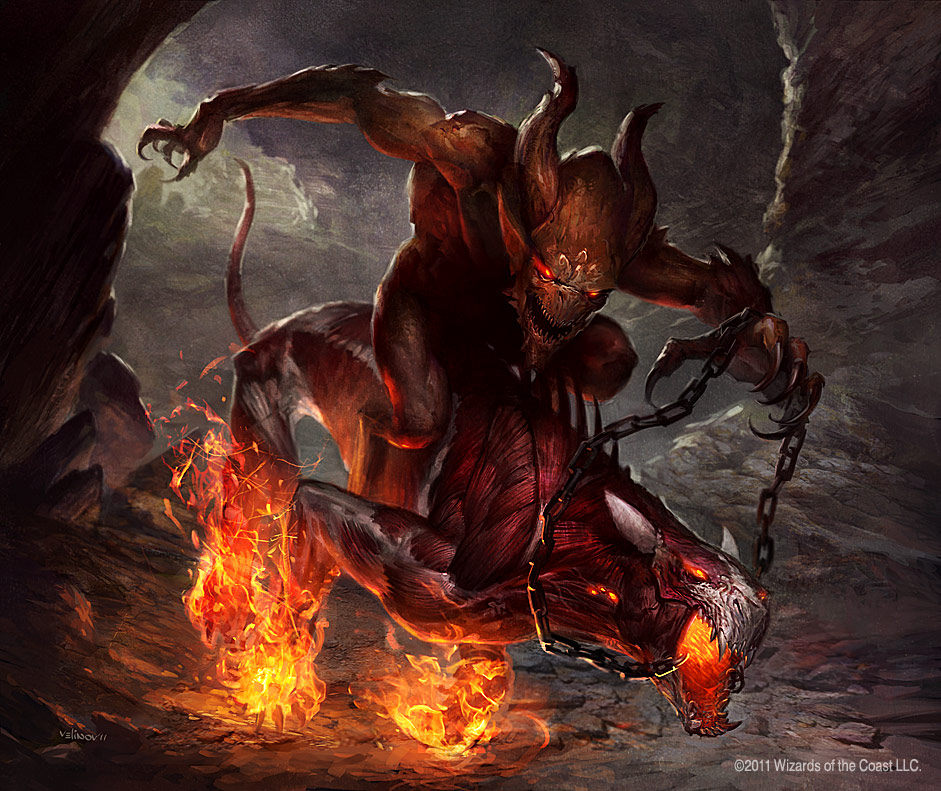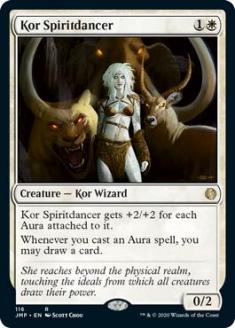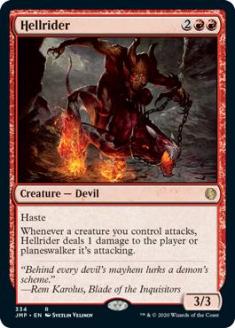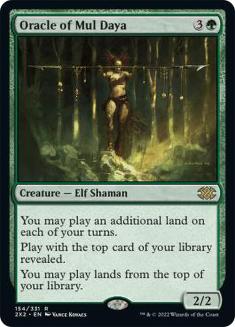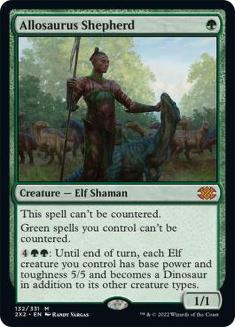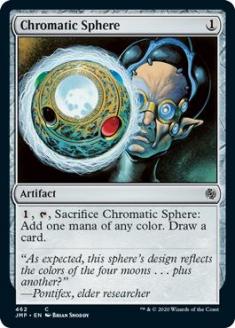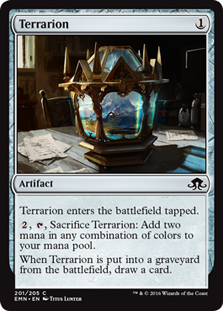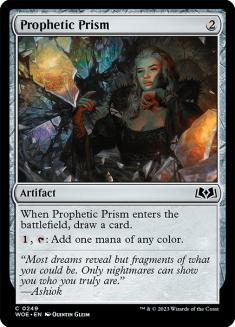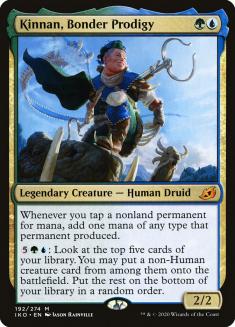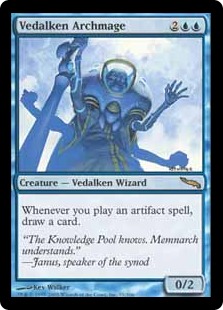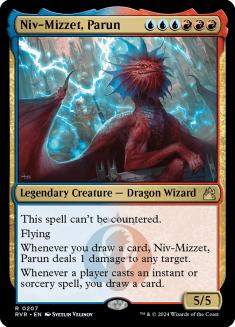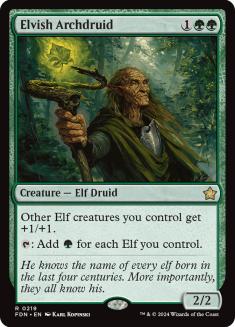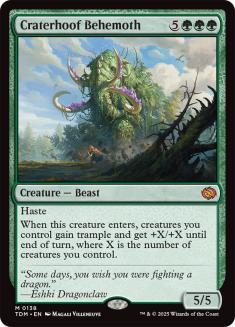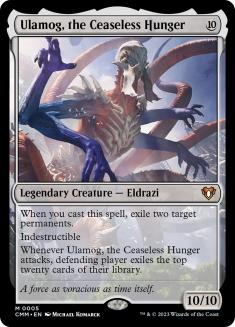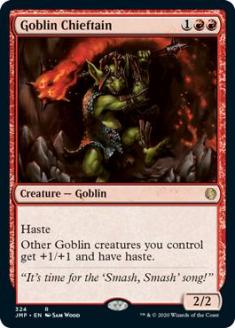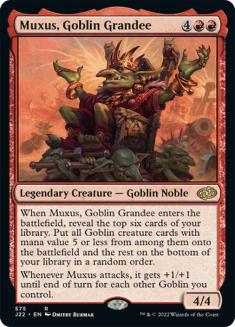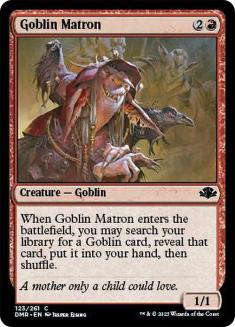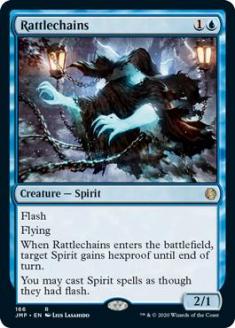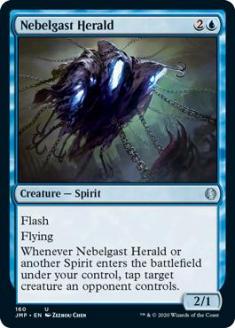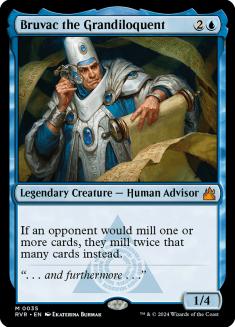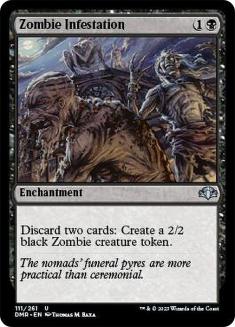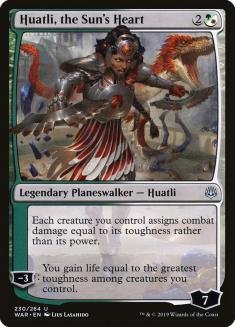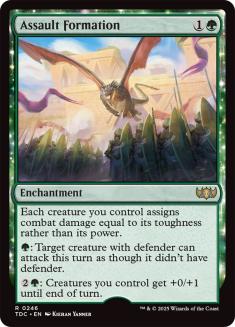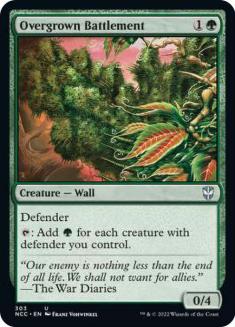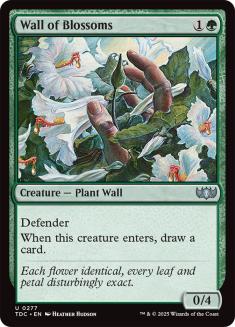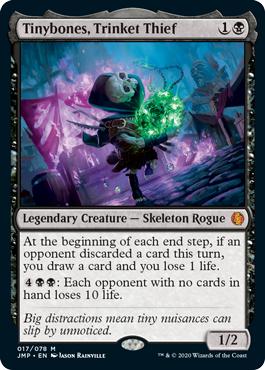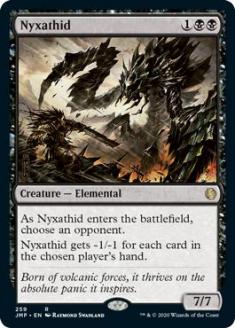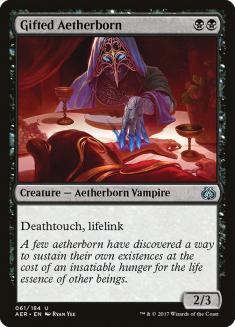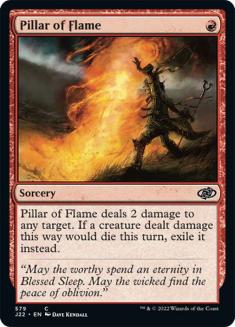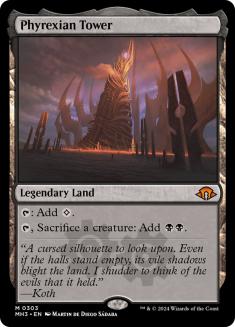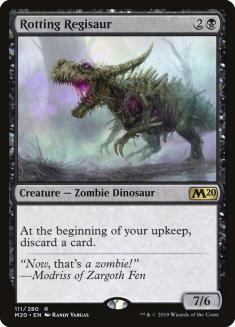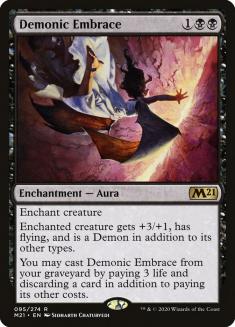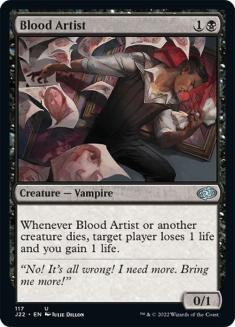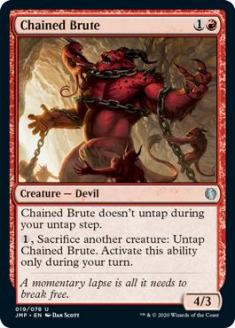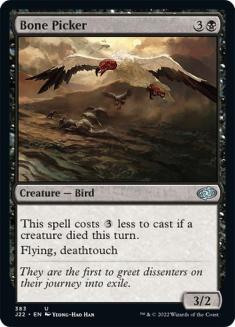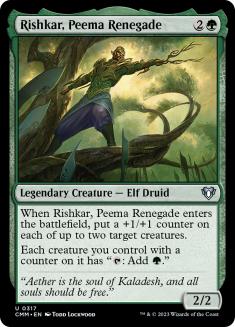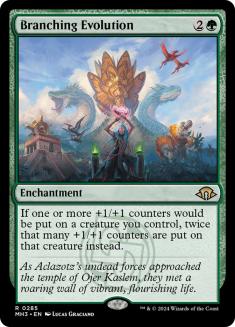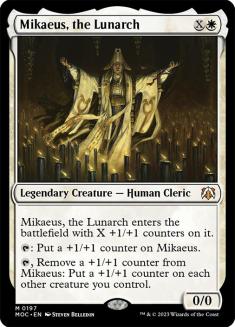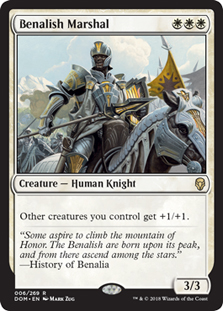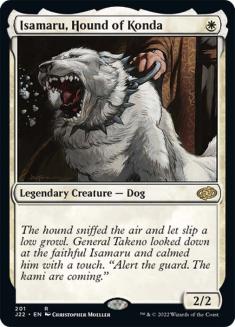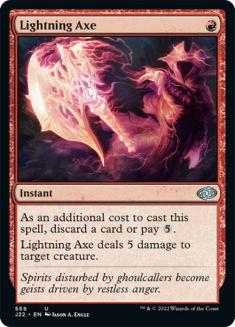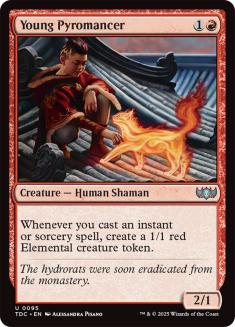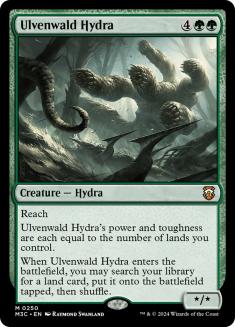Jumpstart will completely change Historic on Magic Arena (Arena). With roughly 300 (!!) cards being injected into the format, its landscape will be completely upended.
With all of the new cards on the horizon, and the seeming lack of buzz around this shift, I wanted to share some of the archetypes I’ll be sinking some time into and where I’ll be starting with them.
With seemingly infinite powerful cards entering the format — both old and new — there’s a ton of space to explore known quantities of the format. The Mythic Invitational in August has its own weight that works as a great motivator to really learn the format in and out, starting with what we know:
Creatures (31)
- 4 Llanowar Elves
- 3 Scavenging Ooze
- 4 Hellrider
- 4 Burning-Tree Emissary
- 4 Pelt Collector
- 4 Zhur-Taa Goblin
- 3 Questing Beast
- 3 Bonecrusher Giant
- 2 Gallia of the Endless Dance
Lands (24)
Spells (5)

One of the best decks in the format got a great “new” aggressive tool in Hellrider. Known for the reach it provides, Hellrider is great for a version of the deck that invests a bit more into the early-game, rather than the mid- and late-game.
Not exactly the most exiting thing to start an article with, right? How about this:
Creatures (16)
Lands (18)
Spells (26)

This is a deck made possible by a smattering of reprints:
Chromatic Sphere is never used for anything fair. The only thing in the universe of fair that comes to mind is enabling the early turns in Tron, which is, uh, not exactly fair. Terrarion is no better.
Prophetic Prism, on the other hand, is primarily used fairly. In years past, Prophetic Prism acted as an Arcum’s Astrolabe for decks that desperately needed mana fixing and planned to play a long game. The difference here?
Kinnan, Bonder Prodigy makes so many of the mana artifacts in the deck worth so much more than they would be normally. Prophetic Prism’s activated ability becomes ramp — as does Chromatic Sphere, Terrarion, and so on. You wanna talk about the most broken thing Mox Amber can do? Look to Kinnan.
Another Jumpstart pickup for the deck is Vedalken Archmage. The card will rarely throw the game on its back and carry it across the finish line, but it does a great job of finding Song of Creation or generating a ton of cardboard with all the air in the deck.
With the 3,000 or so cards that are already available in Historic, adding this many powerful cards absolutely will enable some number of combos.
Some of the combos don’t even depend on an entire deck being built around them. Take for example the tribal decks getting a facelift from Jumpstart:
Creatures (36)
- 4 Llanowar Elves
- 4 Elvish Visionary
- 4 Elvish Archdruid
- 1 Craterhoof Behemoth
- 1 Reclamation Sage
- 2 Rishkar, Peema Renegade
- 2 Marwyn, the Nurturer
- 4 Elvish Clancaller
- 1 Beast Whisperer
- 4 Incubation Druid
- 4 Paradise Druid
- 3 Llanowar Visionary
- 2 Allosaurus Shepherd
Lands (20)
Spells (4)

The most punishing three-drop lord in Magic’s history is back!
Elvish Archdruid is great at pumping the team the turn it enters the battlefield. It’s even better at catapulting its controller into the late-game when cast early. The biggest hurdle has always been untapping with the card. There’s a certain density of must-answer cards that overloads the reactive spells players have available to them and it’s possible this deck is already there.
Craterhoof Behemoth has been the best game-ending curve-topper for green for almost a decade at this point. Having a way to slam the door shut with a pile of mana is incredible.
Before this, the top of ramp decks would frequently just play something like Ulamog, the Ceaseless Hunger; Ugin, the Spirit Dragon; or a big Hydroid Krasis. All powerful cards in their own right, but there’s something incredible about literally ending the game on the spot.
Elvish Archdruid and company being able to help Elves turbo their mana development into the game’s later stages means fewer reason to interact, and Craterhoof plays to that splendidly.
But Elves isn’t the only archetype getting new toys:
Creatures (36)
- 4 Goblin Matron
- 2 Goblin Warchief
- 4 Gempalm Incinerator
- 1 Siege-Gang Commander
- 3 Goblin Ringleader
- 3 Skirk Prospector
- 2 Goblin Chieftain
- 2 Goblin Ruinblaster
- 2 Krenko, Mob Boss
- 2 Fanatical Firebrand
- 1 Goblin Chainwhirler
- 4 Goblin Instigator
- 1 Goblin Trashmaster
- 4 Conspicuous Snoop
- 1 Muxus, Goblin Grandee
Lands (24)

Over the course of the last year, Goblins has quietly been getting some of the best upgrades of any tribal deck. On top of the cards available in the Historic Anthologies and Conspicuous Snoop from Core Set 2021, Jumpstart has all of these goodies:
Goblin Chieftain is great for the deck because it’s more impactful in the mid- and late-game than Goblin Warchief, while being at a similar spot on the curve.
The decklist itself has a smattering of one- and two-of cards because Goblin Matron and Goblin Ringleader allow for that kind of deckbuilding. With those two cards, and now Conspicuous Snoop, giving the deck so much velocity, it has the luxury of being as toolbox-y as ever.
That means that even with only one copy of Muxus in the deck, it’ll still be accessible when it’s relevant. Any more copies of the card would likely overload the deck in its developmental stages.
That being said, with Muxus generating so much battlefield presence on its own, I’m not wholly convinced that centering the deck around Skirk Prospector, Goblin Instigator, and Dragon Fodder isn’t great. That package’s ability to crank Muxus out on the third turn has some real implications that I’ll be interested in fooling around with once Jumpstart is available.
Creatures (34)
- 4 Rattlechains
- 4 Nebelgast Herald
- 3 Remorseful Cleric
- 4 Supreme Phantom
- 4 Empyrean Eagle
- 4 Hanged Executioner
- 4 Spectral Sailor
- 3 Brazen Borrower
- 4 Shacklegeist
Lands (23)
Spells (3)

As more cards are introduced to Historic, decks will more closely resemble their counterparts from older Eternal formats. What Spirits is getting in Jumpstart helps it on two fronts:
As much as some people (me) like to make Welkin Tern jokes about Rattlechains, the card is actually quite nice at protecting creatures from removal spells. It also does a fantastic job of protecting creatures from counterspells by allowing the Spirits pilot to deploy all of the deck’s threats at instant speed.
This is becoming increasingly relevant as the stock of Mystical Dispute rises. Being a blue spell ain’t as easy as it used to be.
Nebelgast Herald gives Spirits the ability to fight against creature decks in Modern, and it’s an enormous pickup for the Historic iteration of the deck. While it isn’t removal, the greatest strength of Spirits has always lain in its ability to dictate the pace of combat.
That’s to say that all of its creature fly. What that means is that as long as Spirits can play defense for long enough, it will theoretically build a large enough battlefield to swing in for the kill. Nebelgast Herald works in both directions for this play pattern, and is going to be a centerpiece of the deck for awhile.
You really thought there were gonna be eighteen decks in this without any memes?
You must be new here.
Lands (55)
Spells (5)

Yes. Seriously.
Jumpstart gives us the tools for one of the most infamous meme decks in the history of the game and I’m just supposed to ignore the elephant in the room?
Please.
Creatures (20)
- 4 Wall of Blossoms
- 4 Overgrown Battlement
- 4 Arcades, the Strategist
- 4 Resolute Watchdog
- 4 Arboreal Grazer
Planeswalkers (6)
Lands (25)
Spells (9)

Speaking of meme decks, this one is dangerously close to making it.
While Huatli, the Sun’s Heart was available previously, it not giving Walls the ability to attack was a real deal-breaker.
With Assault Formation being added to the list of Doran, the Siege Tower-esque effects, having a reliable way to win the game in a deck full of defenders is becoming a reality.
Overgrown Battlement and Wall of Blossoms are some of the best Walls ever printed, and the deck getting both of them is fantastic. Overgrown Battlement in particular begs the question of whether there’s a ramp angle that this package could take.
After all, there are attacking decks that ramp decks want to block.
Creatures (16)
Lands (21)
Spells (23)

Lightning Phoenix is a cool bit of staying power being afforded to decks that want to spew their resources as early as possible. It’s not the biggest thing being gained for red decks, however.
One of the most iconic reprints in Jumpstart, Grim Lavamancer is sure to make waves in Historic for the rest of time. The epitome of high-risk, high-reward, Grim Lavamancer is one of the best ways for red decks to fight creature decks on the battlefield.
Having this sort of tool is relevant because of how few interactive resources Burn is afforded in games that it wins. Having a single card that can cold three or more permanents is huge. It being able to go face ensures that its presence won’t be wasted.
On resource reduction:
Creatures (27)
- 4 Nyxathid
- 4 Pack Rat
- 4 Brain Maggot
- 4 Burglar Rat
- 3 Rotting Regisaur
- 4 Liliana's Steward
- 4 Tinybones, Trinket Thief
Planeswalkers (3)
Lands (24)
Spells (6)

Tinybones, Tinket Thief is messed up. In spite of that, I don’t think this deck is quite there yet.
At its core, a discard deck like this one is looking to reduce both players’ resources and then develop the most punishing thing that it can. The idea is that the opponent won’t prioritize keeping their reactive spells and will get overrun by a three-mana 6/6 or buried in cards by Tinybones.
Unfortunately, without disruption as reliable as Inquisition of Kozilek or Thoughtseize, the actual discard spells in the deck are a bit lacking.
I bring the deck up because the threat suite itself is impressive, and archetypes that are one or two cards away make for useful ideas to keep in your back pocket for later.
8-Rack not quite making it doesn’t mean that other Thoughtseize decks can’t hang:
Creatures (32)
- 4 Phyrexian Obliterator
- 4 Pack Rat
- 4 Gray Merchant of Asphodel
- 4 Gifted Aetherborn
- 2 Ravenous Chupacabra
- 2 Gutterbones
- 4 Knight of the Ebon Legion
- 3 Murderous Rider
- 3 Ayara, First of Locthwain
- 2 Tymaret, Chosen from Death
Lands (25)
Spells (3)

Mono-Black Devotion has quietly gotten a good number of tools over time as a result in the bump in power that threats have been receiving. This incentivizes simply playing to the battlefield and snowballing an advantage, rather than playing reactively and fooling around with Bile Blight or something.
Gifted Aetherborn, in particular, is a subtle win for the deck out of Jumpstart that’s worth mentioning. Look at the sizing of most removal that will be available to Mono-Red once Jumpstart hits:
Outside of Wizard’s Lightning, it’s difficult for Mono-Red (or anything, for that matter) to trade with Gifted Aetherborn that doesn’t result in an even-to-bad mana exchange. When Gruul is the premier aggro deck of the format, Gifted Aetherborn reads closer to “Destroy target attacking creature, gain two life,” with the upside of contributing devotion while on the battlefield.
When inevitability isn’t an issue for a deck, having ways to slow the game down a deck’s primary concern.
Oh, let’s not forget that a land that taps for two mana is entering Historic. Phyrexian Tower is absolutely bananas, and building decks that can accommodate it will be incredibly rewarding.
Creatures (29)
- 4 Diregraf Ghoul
- 1 Pack Rat
- 4 Gifted Aetherborn
- 4 Spawn of Mayhem
- 4 Gutterbones
- 4 Rotting Regisaur
- 4 Knight of the Ebon Legion
- 2 Rankle, Master of Pranks
- 2 Murderous Rider
Lands (24)
Spells (7)

In both of these decks, Gutterbones is doing a ton of heavy lifting. Being a resilient threat against removal is nice, obviously, but helping build a sort of Blood Pet is truly incredible for this deck.
The fundamental goal of most aggressive strategies is sacrificing staying power for short-term power, the end-game being the opponent dying with cards still in their hand. Phyrexian Tower allows for the blistering curve of one-drop, Rotting Regisaur, Demonic Embrace, attack for ten.
You can play your third land now. Thanks for the game.
Creatures (27)
- 4 Blood Artist
- 4 Bone Picker
- 4 Priest of Forgotten Gods
- 4 Mayhem Devil
- 4 Cauldron Familiar
- 3 Kroxa, Titan of Death's Hunger
- 4 Chained Brute
Lands (22)
Spells (11)

“Great art can never be created without great suffering.”
Blood Artist is back, and that means sacrifice decks want to push their core theme to the limit. Counting the opponent’s creatures is such a huge game that cards like Priest of Forgotten Gods are worth playing.
The leaning in to creatures dying every turn unlocks other cards with incredibly high upside, so long as their controller is willing to pay the toll. Needing a ton of bodies to sacrifice will make Dreadhorde Invasion’s stock rise as a way to generate near-infinite sources of sacrifice fuel.
In a deck that’s actively interested in sacrificing its creatures, squint hard enough and Phyrexian Tower starts to look like City of Traitors.
Sacrificing isn’t the only way to get aggressive with synergy:
Creatures (29)
- 2 Scavenging Ooze
- 3 Mikaeus, the Lunarch
- 3 Rishkar, Peema Renegade
- 4 Pelt Collector
- 2 Chamber Sentry
- 3 Voracious Hydra
- 4 Stonecoil Serpent
- 2 Pridemalkin
- 2 Selfless Savior
- 4 Conclave Mentor
Planeswalkers (3)
Lands (24)
Spells (4)

Borrowing the initial idea from the John Roberts II Standard take on the same archetype, this version of the deck is leaning heavily into the green portion of the deck.
The easiest reason to point to as a justification is that Rishkar, Peema Renegade’s mana generation lends itself to paying green costs. Conclave Mentor into Rishkar will do the Winding Constrictor thing from Standard of yesteryear, and it’s something we’ve seen before. What’s new is having multiple forms of Conclave Mentor’s ability in the deck:
Branching Evolution existing in Jumpstart is an addition to the deck that encourages an emphasis on the X-cost creatures in the deck. Why? Because those creatures give the best return on mana when there are multiple instances of additional counters being placed on cards. A Stonecoil Serpent for X=1 will be a 4/4 with a Conclave Mentor and a Branching Evolution on the battlefield.
Cards that can be big on their own, or flood the battlefield when synergies are available, are exactly what the deck wants. The mana efficiency of cheaper spells allowing the deck to flood the battlefield also plays splendidly with Mikaeus, the Lunarch.
Creatures (36)
- 4 Isamaru, Hound of Konda
- 4 Mikaeus, the Lunarch
- 4 Thalia, Guardian of Thraben
- 4 Adanto Vanguard
- 4 Skymarcher Aspirant
- 4 Benalish Marshal
- 4 Dauntless Bodyguard
- 4 Venerated Loxodon
- 2 Tomik, Distinguished Advokist
- 2 Giant Killer
Lands (20)
Spells (4)

Here’s your dream curve:
- Turn 1: One-drop.
- Turn 2: Mikaeus for one.
- Turn 3: More one-drops. Tap everything for Venerated Loxodon.
- Turn 4: Activate Mikaeus. Smush.
In a lot of ways, Mikaeus is like a modal Unbreakable Formation, except over a couple of turns it’s closer to a permanent Pride of Conquerors.
The biggest subtle upside that Mikaeus and Benalish Marshal have over Basri’s Solidarity and Glorious Anthem is the fact that they don’t interact poorly with Thalia, Guardian of Thraben. That isn’t even getting into the fact that they can attack when it comes time to alpha.
Isamaru, Hound of Konda is the special kind of legendary creature that isn’t the worst thing to draw an extra copy of. After all, if it’s connecting and the opponent isn’t killing it, life isn’t that bad. If it’s the point in the game where Isamaru has been invalidated, it’s unlikely the generic 2/1 it’s replacing would get the job done.
If going wide isn’t your thing, there’s more than one way to skin a Bogle:
Creatures (16)
Lands (20)
Spells (24)
- 4 One With the Wind
- 4 Curious Obsession
- 4 All That Glitters
- 4 Staggering Insight
- 4 Karametra's Blessing
- 4 Sentinel's Eyes
Sideboard

Kor Spiritdancer has always been the more glass cannon-y sister of the Hexproof family. Without Gladecover Scout or Slippery Bogle in the format, Auras have to adapt somehow.
Despite being explosive, Kor Spiritdancer has always been incredibly fragile the turn that it hits the battlefield. Luckily, Selfless Savior plays perfectly here. Simply deploying it ahead of Kor Spiritdancer means it’s incredibly likely that she’ll still be around during her controller’s next untap step.
Kor Spiritdancer’s ability to go from zero to twenty is unmatched in its genre and makes a deck like this justifiable in the first place. The amount of churn that Curious Obsession and Staggering Insight offer with Mist-Cloaked Herald makes her easy to find as well.
On the more resilient side of things…
Creatures (13)
Lands (20)
Spells (27)

Lightning Axe providing Izzet Phoenix with a much-needed way to hang against the aggressive green decks of the format is huge. Working as a discard outlet for Phoenix while catching up on the battlefield is the ideal card for a deck like this.
Past dealing with early aggression, one of Arlight Phoenix’s biggest issues is that it has struggled so hard against graveyard hate. In Modern, its answer was Thing in the Ice. Without something like that in Standard or Historic, leaning into the graveyard entirely was a non-starter. Not anymore.
Young Pyromancer is exactly what a deck like Izzet Phoenix wants. Providing chump blockers and a means to turn the corner later on, it’s no accident that Young Pyromancer has been a mainstay in formats that can cast a ton of efficient spells. Considering that Arclight Phoenix already incentivizes this, Pyromancer is a natural fit.
On top of that, Young Pyromancer puts a squeeze on the opponent’s deckbuilding that’s great. Normally, Arclight Phoenix punishes players for having a ton of traditional spot removal in their deck, but Young Pyromancer absolutely punishes eschewing it entirely.
You can also simply create more creatures than anyone could possibly remove.
Creatures (20)
- 3 Oracle of Mul Daya
- 1 Ulvenwald Hydra
- 4 Elvish Rejuvenator
- 2 Hydroid Krasis
- 4 Arboreal Grazer
- 4 Golos, Tireless Pilgrim
- 2 Uro, Titan of Nature's Wrath
Planeswalkers (2)
Lands (30)
- 2 Forest
- 1 Island
- 2 Breeding Pool
- 1 Ghost Quarter
- 1 Bojuka Bog
- 1 Hinterland Harbor
- 1 Golgari Guildgate
- 1 Izzet Guildgate
- 1 Azorius Guildgate
- 1 Rakdos Guildgate
- 1 Selesnya Guildgate
- 1 Simic Guildgate
- 1 Gruul Guildgate
- 1 Dimir Guildgate
- 1 Boros Guildgate
- 1 Orzhov Guildgate
- 1 Maze's End
- 1 Temple of Mystery
- 1 Field of Ruin
- 1 Arch of Orazca
- 2 Blast Zone
- 3 Field of the Dead
- 1 Fabled Passage
- 1 Zagoth Triome
- 1 Ketria Triome
Spells (8)

Land decks are getting some serious upgrades with Jumpstart, most importantly Growth Spiral numbers five through eight in Explore. This is going to be colossal in any decks looking to actually put a ton of lands on the table (ahem, Nexus of Fate) to ramp to four.
Oracle of Mul Daya is another card that’ll reward simply having a ton of cards with the card type “land.” Historic players have already started utilizing Radha, Heart of Keld as a card advantage engine. Oracle of Mul Daya pushes that effect into overdrive. Between Explore, Growth Spiral, and Arboreal Grazer, accelerating to the phases of game that feature Oracle at its most busted will be easy.
Jumpstart also gives the deck access to more virtual copies of Golos, Tireless Pilgrim’s enters-the-battlefield ability in Ulvenwald Hydra.
Like with the effects in Selesnya Counters, if the intent of Wizards of the Coast (WotC) was to introduce redundancy to the format for the sake of consistent archetypes, they’ve done it. From here it’s a matter of simply refining these archetypes and seeing what shakes out as the top dog.

